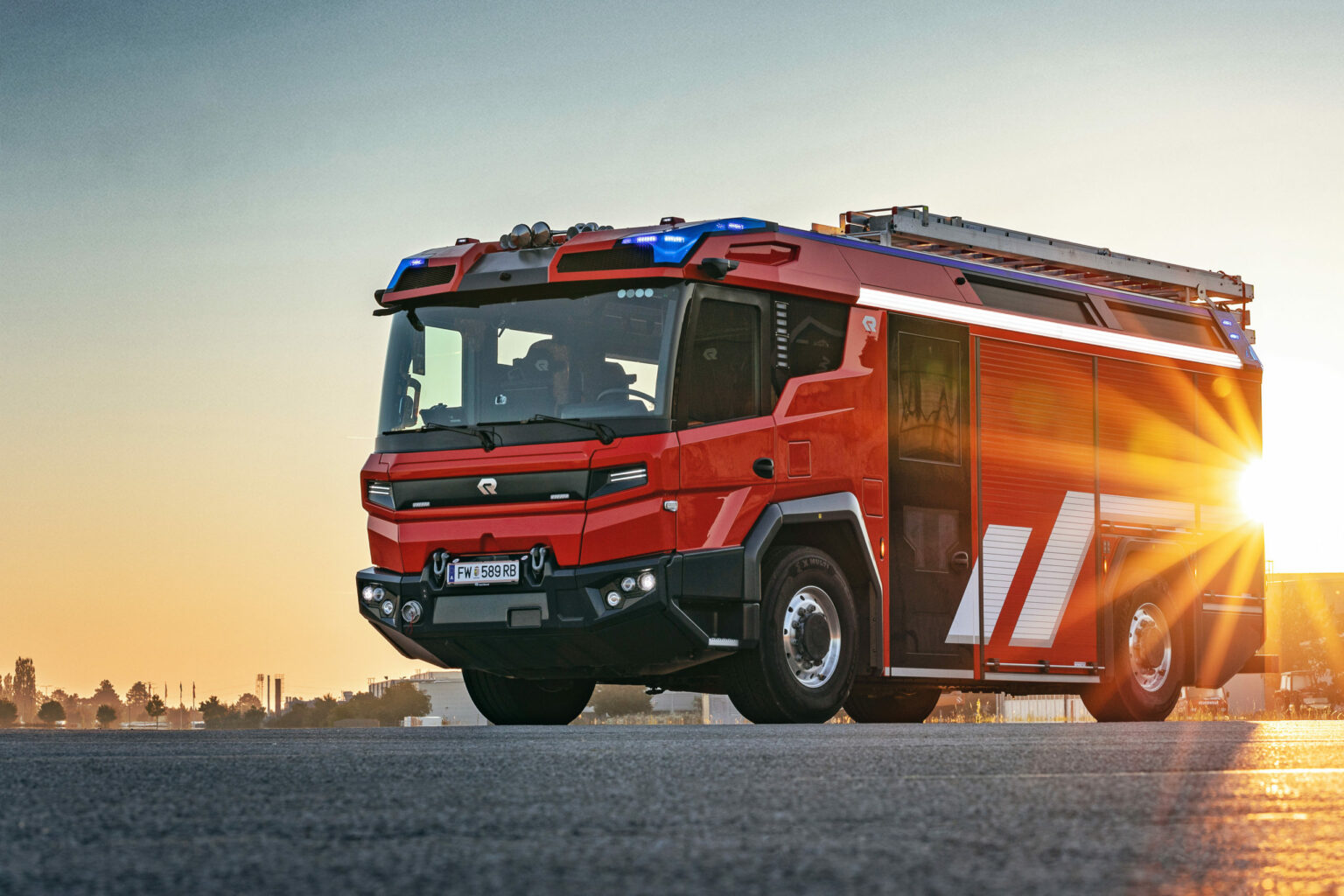Rosenbauer receives award for its electrified firefighting vehicle
- November 12, 2021
- 9:46 am


Iain Hoey
Share this content
Rosenbauer has been awarded the Austrian State Award for Innovation for its electrified firefighting vehicle “Revolutionary Technology” (RT). Margarete Schramböck, Federal Minister for Digital and Economic Affairs, particularly emphasised the sustainability of the RT at the award ceremony: “A great project that really stood out in terms of sustainability. I could convince myself of it.
With this vehicle, Rosenbauer consistently relies on new technologies and thus opens fire departments the way to digital future. The RT once again confirms the innovative strength of the Austrian world market leaders as the basis for economically sustainable models of success. “
“We are delighted to receive this prestigious award and see it as validation of the development work we started ten years ago on this firefighting vehicle”, says Markus Schachner, Head of Rosenbauer Product Development. “From our point of view, the RT combines everything that will be important for the fire departments of the future: a highly ergonomic vehicle architecture, a low-emission drive, an innovative, largely digitalised operating concept and comprehensive connectivity.”
Revolutionary vehicle architecture
The Rosenbauer RT provides a completely independent and trend-setting answer to the question of what the firefighting vehicle of the future will look like. By eliminating the conventional power train, the development engineers were able to largely break away from the classic superstructure philosophy and implement an unprecedented vehicle architecture that was conceived exclusively on the basis of function.
The result is an emergency vehicle from a single source, with unparalleled driving dynamics thanks to its electric drive and excellent handling characteristics on any terrain thanks to its lowerable all-wheel chassis with independent suspension and rear-axle steering. The integral design of the cab ensures a high level of safety during emergency journeys, and the driver is supported by modern assistance systems such as electronic exterior mirrors.
At the operational scene, the RT can be lowered to such an extent that the crew cab can be accessed without obstacles and the equipment stored in the vehicle can be conveniently removed from the floor.
The seats in the cockpit swivel inwards, and the crew in the crew cab sit mostly on the sides of the vehicle, which results in a conference seating arrangement style and allows operational meetings to be held in the vehicle, protected from the wind and weather.
Fully electric operation
With the RT, the fire departments drive into operation fully electrically and with zero local emissions. In addition, recuperation via the electric motors reduces brake wear and thus the creation of fine dust particles. This protects the environment, especially in urban areas with a large number of emergency journeys and a high volume of traffic. And exhaust emissions and noise levels are reduced at the scene because the power for lighting and technical equipment as well as for pump operation is provided by high voltage batteries. This improves the working conditions around the vehicle, reduces the stress levels of the emergency crews and, last but not least, benefits the local residents.
The Berlin fire department, which is currently testing the RT in regular operation, has done the math: more than 90% of their operations can be handled purely electrically. Each electrically powered vehicle would save about 14 tons of CO2 per year compared to a diesel-powered fire-fighting and rescue vehicle. A range extender is on board for long-term use and high-performance operations. This consists of a low-emission car diesel engine and a power generator. This turns the RT into a fully integrated power plant that automatically recharges the batteries when more energy is consumed than available during high power requirements and long operations.
Wireless operator’s panel
The RT is also extensively digitised. The cockpit offers a modern command post, all the functions of the vehicle, from lighting to extinguishing technology, can be controlled via a 17″ display centrally installed in the console. A secure Wi-Fi network, which the RT sets up itself and which can be used for wireless control of any robots, drones, and other electrical equipment, ensures networking at the operational scene. That makes it interesting not just for fire departments, but all disaster control and blue light organisations.
Highest national award
The State Award for Innovation is organised by Austria Wirtschaftsservice GmbH on behalf of the Austrian Federal Ministry for Digital and Economic Affairs. Participants are sent by all Austrian states, which identify them in their own innovation awards. The innovations submitted should be market-ready and initial experience of the effects of the innovations should already be available.
In the case of the RT, both are true: The electric firefighting vehicle was introduced onto the market more than a year ago and has been tested in regular use by the first lead customers since the beginning of 2021. Rosenbauer estimates that more than 3,000 emergency vehicles with comparable technology will be in service by 2030. The company is already working on the electrification of further vehicle types.
Technical Data (RT Berlin)
- Battery capacity: 2 x 66 kWh
- Drive power: 360 kW (max)
- Range extender: 200 kW
- Drive: all-wheel drive via two axle-centric electric motors
- Chassis: independent suspension with air suspension and selectable ride levels
- Rear axle steering selectable (optional)
- Driving assistance systems: EBS, ESP, ADM
- Dimensions: 7,600 x 2,350 x 2,900 mm
- Total permissible weight: 18,000 kg
- Crew: 1 + 6
- Built-in pump: N25 (FPN 10-2000)
- Pressure proportioning system + CAFS
- Extinguishing agent: 1,200 l water + 100 l foam compoun



